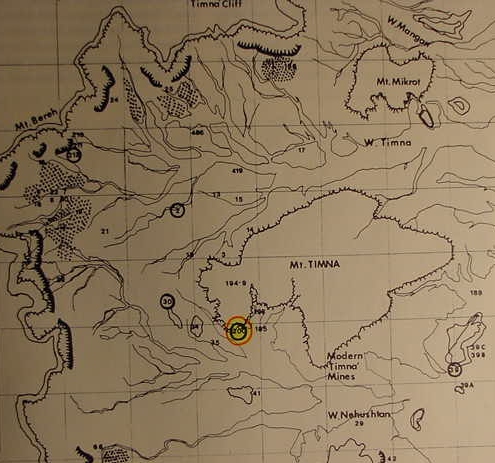Har Timna (Arabic: Gebel Mene'iyeh) in the Arabah
Late Bronze Age and Iron Age site
(Pharaohs Amenhotep III through Rameses V)
Please click here for this website's most important article (Why a "naked" Adam in Eden?)
20 May 2004, Revised and updated through 05 May 2007
Below, an archaeological map of the Timna valley in the southern Arabah, where Late Bronze Age and Early Iron Age I Egyptian worked copper mines have been found. The red circle marks the site of the Hathor Shrine, whose events, in Ramesside times (cartouches of Pharaohs Seti I through Rameses V having been found at the Har Timna Hathor Shrine ca. 1291-1141 BCE), I have argued, in part, may "lie behind" the portrayal of the destruction of the Golden Calf at Mount Sinai or Mount Horeb.
Although many scholars believe that Ain el Qudeirat is Kadesh Barnea, a few still holding out for Ain el Qadeis, neither site has any Late Bronze Age or Iron I wares which would be associated with the Exodus, the earliest wares are Iron II. I have opted for Tel Masos being Kadesh Barnea as it does have the "missing" Iron I wares as well as Amalekite (Rothenberg's Ramesside Negebite wares) and Midianite Wares (Rothenberg's Al-Qurayya wares). Tel Masos is also the EARLIEST and BIGGEST IRON I site in the Negev, quite appropriate for Moses' Kadesh-Barnea.
(For the below map cf. Vol.4, p.1185, Beno Rothenberg, "Timna." Michael Avi-Yonah & Ephraim Stern, Editors. Encyclopedia of Archaeological Excavations in the Holy Land. Englewood Cliffs, New Jersey. Prentice-Hall. 1978. ISBN 0-13-275149-6)
Dr. Geraldine Pinch (PhD) has suggested that Timna may possibly have been founded in 18th Dynasty times by Pharaoh Amenhotep III (ca. 1386-1349 BCE). If she's right, then we have TWO sacred mountains possessing the "missing" Late Bronze Age archaeological debris for the CORRECT SITING of Mount Sinai/Horeb, Serabit el Khadim (Gebel Saniya being nearby) and Har Timna (Gebel Mene'iyeh) at the eastern edge of the Sinai:
"On the basis of the inscribed faience, Rothenberg (1972.132, 171) and Schulman (1976.117, 126) date all the Egyptian faience from Timna to the Ramesside period. Only 25 pieces of votive faience inscribed with royal names were recovered from the temple, compared with nearly 500 from Serabit el-Khadim. The royal names mentioned are Seti I, Ramesses II, Merenptah, Seti II, Tawosret and Ramesses III, IV, and V (Schulman in Rothenberg 1988.145). At Serabit el-Khadim the date range of the 'royal name' faience is from Amonhotpe I to Ramesses VI, but the Ramesside rulers seem to have dedicated a much greater quantity and wider variety of inscribed faience than the 18th dynasty rulers did (1.4.3). Given this, and the troubled history of the Timna temple, if offerings were made there during the 18th dynasty, one would expect only a small proportion of the surviving faience to be of that date.
Most of the non 'royal name' Timna faience can be dated to the Ramesside period by style, technique and material, but some categories provide exceptions. The evidence of the comparitive material from Deir el-Bahri and Serabit el-Khadim suggests that some of the cat figurines found at Timna are 18th dynasty...One of the Timna Hathor masks (1988 fig. 30.1) is similar to the 18th dynasty pieces from Deir el-Bahri (e.g. Pl.30). The fish and flower decoration on some of the faience bowls is of a type usually dated to the 18th dynasty...The use of spiral decoration around the rim of bowls decorated with fish and flowers is charcteristic only of the 18th dynasty (2.11.3.1). Some of the beads common at Timna, such as the corrugated sheroids and gadrooned discs, are usually dated to the 18th dynasty...Much of the glass and some of the pottery could date to the late 18th dynasty (1.5.2). On the basis of the objects themselves, I would suggest that offerings were being made at Timna as early as the reign of Amonhotpe III." (pp. 66-67. "Timna." Geraldine Pinch. Votive Offerings to Hathor. Oxford. Griffith Institute, Ashmolean Museum. 1993)
Other articles of interest:
Please click here for a Map showing the location of the Garden of Eden (in Mesopotamia).
Please click here for a Map showing the River of Eden (the Euphrates) and its Four Branches.
Please click here for Maps of other Biblical sites (in Egypt, the Sinai, Canaan, Transjordan).
